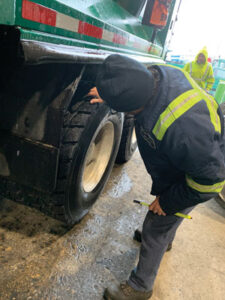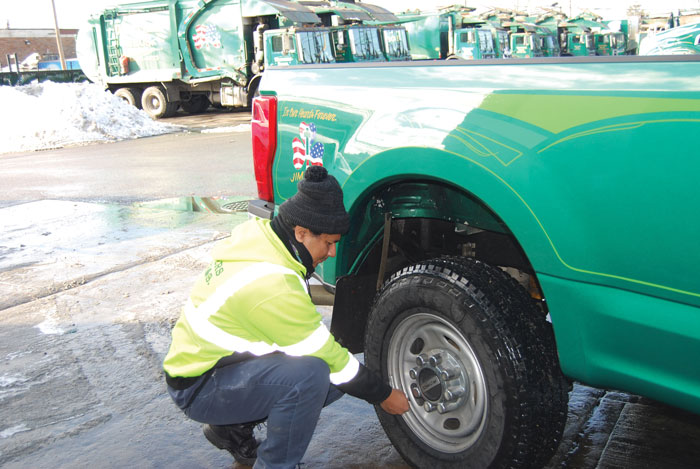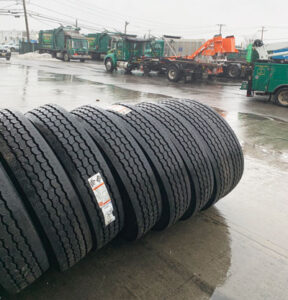Truck tires play an important role in the collection of waste and recyclables. Tires allow the truck to move, steer and stop. Tires also support the fully loaded weight of collection vehicles and absorb shocks from bumps and potholes on roadways.
By Will Flower

When rolling down the road, it is easy to forget about truck tires. However, tires are perhaps the most important safety element on a waste collection vehicle. Think about what tires do—they support the vehicle load, transmit traction to the road, allowing the truck to move, steer and stop, and absorb jolts and bumps from flaws in roadways, including potholes.
Given the significance of tires, it is important to inspect tires as part of the pre-trip and post-trip inspection process. Inspecting and adjusting tires will help to improve safety, increase fuel economy and extend the lifespan of tires. During a tire inspection, a driver or mechanic should check air pressure and the condition of tires by listening for air leaks, looking for signs of uneven tread wear, sidewall damage and bulges in tires. Tires that are over inflated or under inflated should have the air pressure adjusted to prevent uneven tread wear and maximize the effectiveness of the tire on the road.
In most trucks, the proper tire size and the recommended air pressure can be found on a sticker or plate inside the driver’s door jamb (similar to passenger cars). If the sticker with the tire information is missing, consult the vehicle manufacturer’s operating guide to determine the proper air pressure for the tires on the truck.
Inspecting Tires
Inspecting tires is a process and should be part of pre-trip and post-trip inspections. Start by parking the truck on a level surface with adequate lighting. A flashlight will be helpful to review the condition of the tire.
Examine Each Tire
Drivers should look at the tire tread and sidewalls for cracking, cuts, bulges or punctures. Look for and remove any glass, screws or nails that may be embedded in the tread. If the truck has dual tires, look between the tires to ensure there are no rocks or foreign objects stuck between the tires. Tires that are damaged, have excessive tread wear or cracked sidewalls should be removed from service. Finally, examine the valve stem and ensure that there is a valve cap on each stem.

Look at the Tread
Specifically, examine the tread depth and the wear on the tread. Tires need tread for traction, especially during rain and snow. If the tread on the tires is not at the proper depth, it may prevent proper traction with the road surface. Any uneven tread wear should be reported to a mechanic. The vehicle may be out of alignment or the wheel itself may be out of balance. According to Federal Motor Carrier Safety Administration (FMCSA) regulations, “the minimum tread depth for a steer tire is 4/32 of an inch on every major tread groove.”

Check Air Pressure
Drivers should make sure that tires are properly inflated and that they are maintaining proper air pressure. Use a quality air pressure gauge to determine if the tires are properly inflated. Tires needing more air pressure or having too much air, should be adjusted to the proper level. Remember, weather temperatures affect tire pressure. Cold weather will cause tire air pressure to drop, while warm weather will cause tire pressure to increase.
Keeping Tires in Good Condition
Throughout the day, the truck tires are subject to normal wear and tear. Waste collection vehicles face extreme driving conditions especially at transfer stations and landfills. Drivers need to be on the lookout for road hazards that can damage tires and rims. If a driver hits a large curb, pothole or object in the road, he or she should find a safe place to pull off the road and check for damage to the wheel and rim.
Tire inspections are helpful to identify potential safety problems. Equally important is the process to address and repair damaged tires. Ideally, drivers and mechanics will work together to identify and make repairs to keep tires in good condition.
Will Flower is the Senior Vice President of Corporate and Public Affairs at Winters Bros. Waste Systems (Long Island, NY).
Share your safety tip. Submit your suggestions to Will Flower at [email protected].
